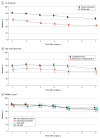A 7-Year Study of the Durability of Improvements in Pain, Physical Function, and Work Productivity After Roux-en-Y Gastric Bypass and Sleeve Gastrectomy
- PMID: 36103179
- PMCID: PMC9475385
- DOI: 10.1001/jamanetworkopen.2022.31593
A 7-Year Study of the Durability of Improvements in Pain, Physical Function, and Work Productivity After Roux-en-Y Gastric Bypass and Sleeve Gastrectomy
Abstract
Importance: Bariatric surgical procedures are associated with clinically important improvements (CIIs) in pain and physical function. However, there are declines in initial improvement by the third postoperative year, and the long-term durability of improvements are not well-described.
Objective: To evaluate the durability of improvements in pain and physical function through 7 years after Roux-en-Y gastric bypass (RYGB) or sleeve gastrectomy (SG).
Design, setting, and participants: This study is part of the Longitudinal Assessment of Bariatric Surgery-2 (LABS-2), a cohort study at 10 US hospitals. Adults with severe obesity (ie, body mass index of 35 or greater) undergoing bariatric surgery were assessed preoperatively (2006-2009) and followed up annually for as long as 7 years or until 2015. Of 1829 participants who underwent RYGB or SG in LABS-2, 338 were excluded from this study because they had a follow-up period of less than 5 years. Analysis of participants who underwent RYGB or SG and completed research assessments preoperatively and postoperatively for 5 to 7 years was conducted from March to April 2022.
Main outcomes and measures: Preoperative-to-postoperative CIIs in pain and physical function scores from the 36-Item Short Form Health Survey and the Western Ontario McMaster Osteoarthritis Index, and 400-meter walk time, using previously established thresholds; and remission of mobility deficit, ie, inability to walk 400 meters in 7 minutes or less.
Results: A total of 1491 individuals were included, with 1194 (80%) women; 59 (4%) Hispanic, 164 (11%) non-Hispanic Black, and 1205 (82%) non-Hispanic White individuals; a preoperative median (IQR) age of 47 (38-55) years; and a preoperative median (IQR) body mass index of 47 (42-52). Between 3 and 7 years after surgery, the percentage of participants with preoperative-to-postoperative CIIs in bodily pain decreased from 50% (95% CI, 48%-53%) to 43% (95% CI, 40%-46%), in physical function from 75% (95% CI, 73%-77%) to 64% (95% CI, 61%-68%), and in 400-meter walk time from 61% (95% CI, 56%-65%) to 50% (95% CI, 45%-55%). Among participants with a preoperative mobility deficit, remission decreased from 50% (95% CI, 42%-57%) to 41% (95% CI, 32%-49%), and among participants with severe knee or hip pain or disability, the percentage with CIIs in knee and hip pain and function decreased (eg, hip pain: from 77% [95% CI, 72%-82%] to 65% [95% CI, 58%-72%]; knee function: from 77% [95% CI, 73%-82%] to 72% [95% CI, 67%-77%]).
Conclusions and relevance: In this cohort study, despite decreases in preoperative-to-postoperative improvements across follow-up, CIIs in perceived bodily and joint-specific pain and in self-reported and objectively measured physical function ranged from 41% to 72%, depending on the measure and subgroup, 7 years after surgery, suggesting that RYGB and SG are commonly associated with long-term CIIs in pain and physical function.
Conflict of interest statement
Figures

Similar articles
-
Change in Pain and Physical Function Following Bariatric Surgery for Severe Obesity.JAMA. 2016 Apr 5;315(13):1362-71. doi: 10.1001/jama.2016.3010. JAMA. 2016. PMID: 27046364 Free PMC article.
-
Comparing the 5-Year Diabetes Outcomes of Sleeve Gastrectomy and Gastric Bypass: The National Patient-Centered Clinical Research Network (PCORNet) Bariatric Study.JAMA Surg. 2020 May 1;155(5):e200087. doi: 10.1001/jamasurg.2020.0087. Epub 2020 May 20. JAMA Surg. 2020. PMID: 32129809 Free PMC article.
-
Thirty-day outcomes of sleeve gastrectomy versus Roux-en-Y gastric bypass: first report based on Metabolic and Bariatric Surgery Accreditation and Quality Improvement Program database.Surg Obes Relat Dis. 2018 May;14(5):545-551. doi: 10.1016/j.soard.2018.01.011. Epub 2018 Jan 13. Surg Obes Relat Dis. 2018. PMID: 29551470
-
Predictors of glycemic control after sleeve gastrectomy versus Roux-en-Y gastric bypass: A meta-analysis, meta-regression, and systematic review.Surg Obes Relat Dis. 2018 Dec;14(12):1822-1831. doi: 10.1016/j.soard.2018.08.027. Epub 2018 Sep 8. Surg Obes Relat Dis. 2018. PMID: 30385071
-
Systematic Review and Meta-Analysis of Randomised Controlled Trials Comparing Long-Term Outcomes of Roux-En-Y Gastric Bypass and Sleeve Gastrectomy.Obes Surg. 2020 Feb;30(2):664-672. doi: 10.1007/s11695-019-04235-2. Obes Surg. 2020. PMID: 31724116
Cited by
-
Functional mobility and pain are improved for 6 years after adolescent bariatric surgery.Obesity (Silver Spring). 2025 Jun;33(6):1126-1135. doi: 10.1002/oby.24285. Epub 2025 Apr 21. Obesity (Silver Spring). 2025. PMID: 40259728 Free PMC article.
-
Postoperative pain-related outcomes and perioperative pain management in China: a population-based study.Lancet Reg Health West Pac. 2023 Jun 10;39:100822. doi: 10.1016/j.lanwpc.2023.100822. eCollection 2023 Oct. Lancet Reg Health West Pac. 2023. PMID: 37927993 Free PMC article.
-
Impact of bariatric surgery on premenopausal women's womanliness: A qualitative systematic review and meta-synthesis.PLoS One. 2024 Aug 29;19(8):e0308059. doi: 10.1371/journal.pone.0308059. eCollection 2024. PLoS One. 2024. PMID: 39208194 Free PMC article.
-
Rheumatic Diseases Following Metabolic and Bariatric Surgery: A Systematic Review and Meta-Analysis.Obes Surg. 2025 Feb;35(2):624-634. doi: 10.1007/s11695-024-07652-0. Epub 2025 Jan 2. Obes Surg. 2025. PMID: 39743656
-
Pre-post changes of integrated care needs in patients undergoing bariatric surgery.Int J Obes (Lond). 2025 May 19. doi: 10.1038/s41366-025-01797-3. Online ahead of print. Int J Obes (Lond). 2025. PMID: 40389646
References
Publication types
MeSH terms
LinkOut - more resources
Full Text Sources
Research Materials
Miscellaneous

